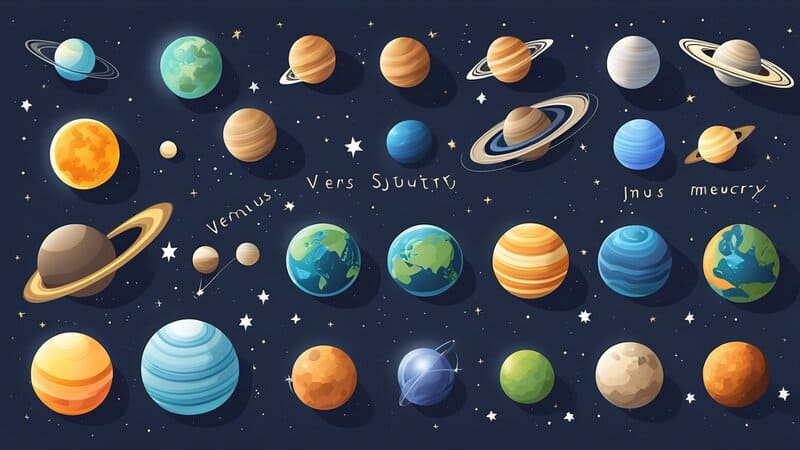Have you ever found yourself staring at the night sky, captivated by its vastness yet unsure of the celestial spectacles before you?
The vast universe can feel overwhelming; without guidance, many of its marvels remain nameless twinkles to the untrained eye.
What are the brightest objects in the Night Sky?
The brightest objects you’ll see in the night sky are typically planets, stars, and the Moon. Specifically, Venus often stands out as the “Evening Star” or “Morning Star,” while Sirius is the brightest star. Of course, our Moon often dominates when it’s in its full phase.
My comprehensive guide is tailored for you, the amateur astronomer. Being an amateur astronomer myself, I’ve always sought ways to better understand the night sky. I have decoded the night’s most luminous attractions, from our reliable Moon to distant stars and planets, ensuring your next gaze upward is informed, awe-inspiring, and deeply satisfying.
Let’s dive right in.
Recommended For You
Luminaries of the Night Sky

Have you ever gazed at the night sky and wondered what those bright specks of light were?
The nighttime sky is a treasure trove of celestial wonders, from stars and planets to the most brilliant of them all, our Moon. I remember the excitement of spotting Saturn’s rings for the first time with my own eyes.
Let’s dive into the marvels of the night sky and explore some of the wonderful objects that sparkle above us.
What is the Brightest Object in the Sky?
| No. | Object | Description | Magnitude |
|---|---|---|---|
| 1 | Sun | Central star of our solar system | -26.74 |
| 2 | Moon | Earth’s natural satellite | -12.74 (full) |
| 3 | Venus | Second planet from the Sun; known as “Evening Star” | -4.89 (max) |
| 4 | Mars | Fourth planet from the Sun; known as the “Red Planet” | -2.91 (max) |
| 5 | Jupiter | Largest planet in the solar system | -2.94 (max) |
| 6 | Mercury | Smallest and closest planet to the Sun | -2.48 (max) |
| 7 | Saturn | Sixth planet from the Sun; known for its rings | -0.55 (max) |
| 8 | Uranus | Seventh planet from the Sun; an ice giant | 5.32 (avg) |
| 9 | Sirius | Brightest star in Earth’s night sky | -1.46 |
| 10 | Capella | A prominent star in the constellation Auriga | 0.08 |
| 11 | Rigel | Blue-white supergiant star in Orion constellation | 0.18 |
| 12 | Ganymede | Largest moon of Jupiter | 4.6 (avg) |
| 13 | Io | Jupiter’s moon known for its intense volcanic activity | 5.0 (avg) |
| 14 | Europa | Ice-covered moon of Jupiter with subsurface ocean | 5.3 (avg) |
| 15 | Asteroid Vesta | One of the largest objects in the asteroid belt | 5.1 (max) |
Please note:
- Magnitude is an inverted scale, where lower numbers (or negative numbers) mean brighter objects.
- The magnitudes provided for the planets vary depending on their position relative to Earth and the Sun. I’ve given the maximum brightness for some where it’s variable. Among these celestial wonders, Venus, Mars, and Jupiter stand out as the brightest planets visible to the naked eye.
- The magnitude values for the moons of Jupiter (Ganymede, Io, and Europa) are average values. They can vary depending on their position relative to Jupiter and Earth.
- Magnitudes for stars (like Sirius, Capella, and Rigel) are relatively constant.
A Glimpse into the Sky’s Amazing Marvels
When observing the night sky, some objects appear brighter than others. This difference in brightness is measured using a scale called magnitude. Objects classified as 1st magnitude are among the brightest stars in the sky.
The lower the magnitude number, the brighter the object appears to our unaided eye. It’s important to understand that this system only applies to what is visible without a telescope or binoculars.
Our reliable companion, the Moon, undoubtedly takes the crown as the brightest object in the night sky. Its brightness varies depending on its phase and reaches a maximum apparent magnitude of -12.74.
Moving on, the planets of our solar system also add a dazzling touch to the sky. Understanding the planets in order helps identify them during stargazing sessions.
Venus is a prime example, earning the top spot of the brightest planet with a maximum apparent magnitude of -4.8. Jupiter, Mars, and Mercury also join the ranks of some of the top 5 brightest objects in the night sky.
Venus made the news, back in February 2022.
In addition to our Moon and planets, stars like Sirius and Canopus stand out as bright beacons. They might not be as luminous as the Moon or Venus, but they have charm.
Next time you find yourself admiring meteors or star clusters, watch for these luminous objects. It’s a unique experience to connect with the universe and appreciate the celestial splendor that unfolds above us.
So, step outside and let the brightest stars guide your way under dark skies.
Natural Illuminators: The Prominence of the Sun and Moon

The Sun: Our Stellar Neighbor
Although not visible at night, the Sun plays a significant role in the sky’s brightness.
It’s the largest and brightest object in our solar system, providing light and warmth to Earth.
Fun facts: The Sun also goes through various activity levels in an 11-year cycle called the Solar Cycle 25.
Always wear proper eye protection to avoid damaging your eyes when viewing the sun. One of the most spectacular events related to the Sun is the annular solar eclipse, which occurs when the Moon blocks out most of the Sun’s light, leaving a glowing ring.
The Moon: Earth’s Shimmering Satellite
The Moon is the brightest object in the night sky. As it orbits Earth, we see different parts of the Moon illuminated, resulting in various Moon phases. For instance, the waxing crescent moon appears as a thin crescent shape, as only a tiny part of the Moon is lit up by the Sun.
Here are some tips for observing the Moon:
- Find a spot with minimal light pollution to get a better view.
- Use a telescope or binoculars to see more details, like craters.
Here’s a quick rundown of the Moon phases:
- New Moon: not visible, as the side illuminated by the Sun faces away from Earth.
- Waxing Crescent: a slight crescent shape becomes visible as more of the Moon is illuminated.
- First Quarter: half of the Moon appears lit up.
- Waxing Gibbous: more than half, but not fully illuminated.
- Full Moon: the whole Moon is visible and brightly lit.
- Waning Gibbous is similar to Waxing Gibbous but reversed.
- Third Quarter: half of the Moon is illuminated, opposite the First Quarter.
- Waning Crescent: a tiny sliver of the Moon remains visible before returning to the New Moon phase.
Remember to use proper eye protection when viewing the Sun, and enjoy observing the Moon’s different phases as it lights up the night sky.
Dazzling Planets: Venus, Mars, Jupiter, Mercury, Saturn, and Uranus

Venus: The Evening Star
Venus, often called the Evening Star, is our closest neighbor and the brightest planet in the night sky. Its dazzling brightness is due to its thick clouds, which reflect sunlight.
To spot Venus, look for a bright object in the west after sunset or in the east before sunrise.
Mars: The Red Wanderer
Mars, known as the Red Wanderer, has a distinct red-orange hue. This is because its surface is covered in iron oxide, or rust, which gives it that unique color.
Search for a reddish-toned light moving slowly across the sky to find Mars.
Jupiter: The Giant of Our Solar System
Jupiter, the largest planet in our solar system, is another bright object to look for in the sky. It has a yellowish-white glow, and with a small telescope, you can even see its four largest moons: Io, Europa, Ganymede, and Callisto.
Jupiter is visible during the early evening in the south or southeast sky.
Mercury: The Swift Planet
Mercury is the smallest and swiftest planet in our solar system. It’s not as bright as Venus or Jupiter but can still be visible under the right conditions.
Look for Mercury low in the sky just before sunrise or shortly after sunset.
Saturn: The Ringed Beauty
Saturn, the famous ringed planet, is known for its stunning and complex system of rings. While not as bright as Venus or Jupiter, it can still be seen with the naked eye and appears as a golden-yellow object.
Use a telescope to get the best view of Saturn and its rings.
Uranus: The Distant Ice Giant
While not as bright as the other planets mentioned, Uranus can still be spotted as a faint, greenish-blue speck in a dark sky. It’s the farthest ice giant in our solar system, and you’ll need a telescope or strong binoculars to get a better view of it.
To locate Uranus, look for it in the eastern sky during the autumn and winter.
FREE STARGAZING CHECKLIST
My 5-page Stargazing Checklist will enhance your astronomical observations.
Follow this free checklist to navigate the night sky with confidence, clarity, and a sense of preparedness for a rewarding stargazing experience.

Stellar Beacons: Sirius, Capella, and Rigel

Sirius: The Dog Star’s Brilliance
Sirius, also known as the Dog Star, is the brightest star in the night sky. It’s part of the Canis Major constellation. It has a maximum apparent magnitude of -1.47, making it easily visible to the naked eye.
You’ll be able to recognize it for its dazzling white and blue hues. Sirius has been admired by ancient civilizations for its beauty, owing to its shining presence in the sky.
Read more: What is the brightest star in the California night sky?
Capella: The Goat Star’s Glow
The sixth-brightest star in the sky, Capella, can be found within the constellation Auriga as it shines with a golden glow. Also known as the Goat Star, Capella has a fascinating history, and its name comes from the Latin word “capra,” meaning goat.
Nearby, you can spot a small triangle of stars playfully known as “The Kids,” symbolizing the offspring of the mythical goat.
Rigel: Orion’s Brightest Gem
Rigel is the brightest star in the constellation Orion, boasting its position as the seventh-brightest star in the night sky.
The star has a magnitude of 0.12 and exhibits a mesmerizing blue-white glow. When a celestial body reaches its highest point in the sky, it’s said to be at its zenith, offering the best viewing clarity.
Rigel is part of a triple star system, with its two fainter companions making the array an exciting sight for stargazers. As you observe Orion, Rigel will be easy to find as it illuminates the constellation’s “foot.”
So, on your next stargazing adventure, be sure to find these stellar beacons that capture the magnificence of our night sky. Their brilliance, colors, and unique characteristics are a sight to behold.
Exploring Jupiter’s Satellites: Moons Ganymede, Io, and Europa

When gazing up at the night sky, Jupiter and its largest moons – Ganymede, Io, and Europa – are among the most fascinating objects for amateur astronomers.
Let’s explore these incredible celestial bodies and uncover some fantastic features.
Ganymede: Jupiter’s Largest Moon
Ganymede is the largest Moon of Jupiter and the biggest Moon in our entire solar system. To put this in perspective, Ganymede is even more significant than the planet Mercury!
Its surface is a mix of ice and rock, with an intricate pattern of dark and light areas.
When you look at Ganymede:
- Consider using binoculars or a telescope to observe its impressive size.
- Appreciate its fascinating surface features, which are visible with the right equipment.
- Remember, you’re observing the solar system’s largest Moon – quite a sight!
Io: The Volcanic Wonder
It is a unique moon in our solar system, with an incredibly active volcanic surface. The intense volcanic activity makes Io the most geologically active world in our neighborhood.
As you watch Io through your telescope:
- Be aware that the colors you see result from sulfur and other materials from the volcanic eruptions.
- Enjoy that you’re observing an extraordinary celestial body – there’s nothing quite like Io out there!
- Follow the Moon’s changes over time as the volcanic activity continuously transforms its appearance.
Europa: Icy Surface, Hidden Oceans
Europa, Jupiter’s most miniature Galilean Moon, boasts an icy surface with a vast, hidden ocean underneath. Scientists believe that its subsurface ocean could potentially harbor life.
When you set your sights on Europa:
- Admire the beautiful cracks and lines across its icy surface caused by the underlying sea.
- Ponder the possibilities of life in Europa’s hidden depths – who knows what mysteries lie beneath the ice?
- Celebrate the chance to observe such a remarkable and intriguing moon up close.
By exploring these impressive moons orbiting Jupiter, you’ll gain a newfound appreciation for our solar system’s astonishing beauty and diversity.
Don’t be afraid to grab your favorite stargazing gear and embark on an unforgettable celestial adventure!
Notable Appearances: Asteroid Vesta and Mars’ Unique Seasons

Asteroid Vesta: The Bright Rock of Space
Vesta, the brightest asteroid in the sky, is sometimes visible from Earth with the naked eye. Vesta reaches its closest distance to Earth in June, making it easier to spot.
To find Vesta in the night sky:
- Look between Saturn and the red star Antares in mid-June.
- Wait for an evident and dark night.
- Use binoculars for a better view if you struggle to spot it.
Vesta’s high surface brightness makes it a stunning sight, shining like a bright rock in the vastness of space.
Mars: Seasons of Visibility
Mars offers a fantastic view when its unique seasons align for the best visibility.
To enjoy watching the Red Planet:
- Make sure it’s in opposition, meaning it’s directly opposite the Sun from Earth.
- Look for it during late summer or early fall when Mars is brighter.
- Note that its brightness can reach magnitude 5, making it easy to see.
Mars’ brightness varies due to its elongated orbit, bringing it closer or farther away from Earth. Watch astronomy news and events to catch Mars and Vesta in their best light.
Capturing the Celestial: Top Tips for Astrophotography

Astrophotography is a fun hobby that lets you capture breathtaking images of celestial objects. Capturing the perfect image requires patience, equipment, and optimal conditions.
To get started, pick a location away from city lights for clearer skies and better visibility. Choose a spot with minimal light pollution to get the most out of your photographic experience.
Next, consider your optical aids. While taking impressive night-sky photos with just a camera and tripod is possible, a telescope or a high-quality camera with larger aperture lenses can help you spot distant objects like Neptune or even deep-sky objects.
Here are some tips for capturing exceptional shots of celestial objects:
- Always use a sturdy tripod for stability.
- Opt for a camera with an aperture of f/2.8 or wider.
- Set your camera to manual or bulb mode, and adjust the white balance to daylight or auto.
Now, let’s explore specific subjects to capture depending on your location in the Northern or Southern Hemisphere.
Snapshots of the Skies: Northern Hemisphere
- Milky Way Galaxy: During the summer months, the core of our Milky Way Galaxy is visible, creating a stunning backdrop for your celestial pictures.
- Transient objects: Watch for meteor showers like the Orionid Meteor Shower, which peaks in late October.
- Zodiacal Light: Around the equinox time, the zodiacal light is visible, a faint cone-shaped glow appearing in the western evening sky after dusk.
Gaze at Galactic Wonders: Southern Hemisphere
- Scorpius: This celestial scorpion is prominent in the sky during winter, making it a captivating object for photography.
- Pleiades: Also known as the Seven Sisters, this bright star cluster is visible in winter and is a beautiful addition to any night sky photo session.
Astrophotography can be a rewarding way to explore the universe from the comfort of your backyard. Use these tips as your starting point, and remember that patience and practice are essential for perfecting your celestial captures.
Frequently Asked Questions
What determines the brightness of celestial objects to the human eye?
As our eyes perceive, the brightness of celestial objects is determined by a scale called magnitude. The lower the magnitude number, the brighter the object appears to the naked eye without the aid of telescopes or binoculars.
How can one differentiate between the various phases of the Moon?
The Moon goes through different phases based on how much its illuminated side faces the Earth. For instance, during a Full Moon, the entire Moon is illuminated. At the same time, a Waxing Crescent only reveals a thin crescent shape. Observing the lit portion helps determine its phase.
What makes Venus so distinguishable in the night sky?
Venus is often called the “Evening Star” because of its brightness. Its brilliance is primarily due to its thick clouds, which efficiently reflect sunlight, making it the brightest planet in the night sky when observed during the evening or morning.
Summary: Brightest Objects in the Night Sky
Thank you for reading my article about the brightest objects in the night sky.
Our universe is a mesmerizing canvas, from the ever-shining brilliance of the Moon and Venus to the unique beauty of Mars and Jupiter’s moons. Distant beacons like Sirius and Capella guide our gazes, while phenomena such as the zodiacal light and the Milky Way leave us in awe.
As we peer into the vast expanse of the cosmos, we are continually humbled by its grandeur. From the ethereal beauty of nebulae, painting the canvas of space with their vibrant hues, to the majestic sprawl of distant galaxies, each holding billions of stars and untold mysteries.
Our understanding, shaped by theory and observation, evolves with every new discovery, reminding us of the dynamic tapestry of the universe. Moments like a conjunction, when celestial bodies align harmoniously, remind us of our place in this vast cosmic ballet.
Let us remain curious, ever eager to unravel the universe’s enigmas and appreciate its awe-inspiring wonders.
As amateur astronomers, each look upwards reconnects us with the vast cosmos, revealing familiar sights and new mysteries. With each night’s observation, let the luminaries of the night sky be your guide, and may your stargazing always be filled with wonder.
Happy Stargazing!
Read additional articles in my Night Sky series:




